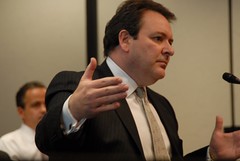
help make the agency more “efficient
and multimodal.”
(Photo © J. Maus)
Matt Garrett, Director of the Oregon Department of Transportation (ODOT) has sent out a memo via email to staff and stakeholders throughout the state that he is moving forward with a significant structural shift for the agency.
Writing that, “It is now time to take our first steps to pursue a more multimodal vision in operating and conducting our businesses,” Garrett says his move will consolidate separate programs — like the Bicycle/Pedestrian Program, Transportation Enhancements, and others — into a new, “Active Transportation” section within ODOT. (Note that a “section” is a less formal entity than a “division”)
Read an excerpt from his email below (emphasis mine):
“This is consistent with the direction I have received from Governor Kitzhaber and the Oregon Transportation Commission, and complements our efforts to “right-size” the agency, which I have spoken about before.
The funding picture remains as it was six months ago – declining on both state and federal fronts. It is even more important now that we get the most benefit from every dollar regardless of its cycle or source.
Our funding structure is overwhelmingly dedicated to highway programs, so we have to be imaginative in how we use discretionary funds and other funding that is directed to non-highway programs. The problem we have had historically is that programs, such as Scenic Highway, Bicycle/Pedestrian, Transportation Enhancement, and others have naturally operated independently based on their own funding cycles. While the state has invested in good projects that have contributed to the communities they serve in many ways, collectively they may or may not have contributed to strategic improvement of the transportation system.
I think by bringing more discipline to the process and developing a new frame of reference through which we see proposals, we can be more strategic and we can leverage the funds to get a bigger system impact.
The next step is to create a new “Active Transportation” section that will bring together separate programs into a more effective and efficient whole. Eventually, I would like to see a division reporting to the Deputy Director for Operations, but for now, we will start with a section.
The vision is to integrate programs and funding sources to support the selection and delivery of projects that are multidimensional transportation projects, not just a “highway” or “bikeway” or “transit” project. We want strategic project selection that provides complete transportation solutions for communities and takes advantage of the unique features of each program and funding source.
These changes should generate efficiencies and help us make sure we obligate all our federal funds in each program each year.
As a start to create this new section, we will combine various programs that involve local governments and some of the various transportation programs into a new section within TDD [the Transportation Development Division]… These include the Local Program section, Transportation Enhancement, ConnectOregon, Flex Funds, Bicycle/Pedestrian, Scenic Byways, and the Sustainability program, currently housed in the director’s office. We will integrate these to provide the best community projects we can from planning to delivery…
I believe these changes will advance the agency objectives of efficiency, make it more multimodal in nature and approach, enhance the agency’s ability to make strategic and cost effective project choices, and help us get to our right-sizing goals.”
Garrett says the management shifts would happen in August and should be in place by this fall.
Advocates and others around the state are likely to receive this news with some degree of skepticism. It’s no secret that ODOT has been a highway-centric agency in the past. However, there are strong signs that that culture is waning and they are truly committed to a new paradigm. How this all plays out remains to be seen.
I’m still tracking down comments and background on what spurred this shift and what it might mean for transportation policy in Oregon. Stay tuned.

